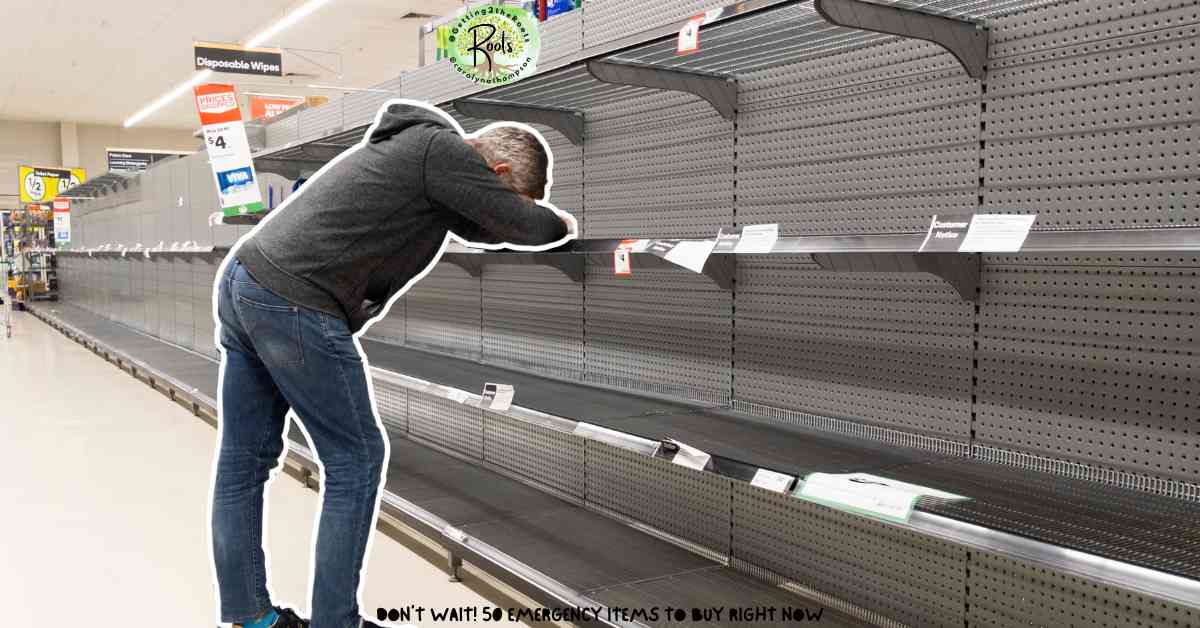Prices keep rising and emergency items often vanish fast when tariffs, war, or supply problems hit. Our people have always stayed ready through hard times.
From slavery and segregation to disasters like Katrina, we knew preparation was survival. This post shows you what to get now before shelves go empty or costs double.
Emergency items disappear quickly once the news breaks. A simple alert about conflict or shortages can wipe out store shelves in hours. That’s why acting early matters. Supply chains break. Inflation spreads.
And basic things like toilet paper, soap, or canned goods can suddenly cost twice as much, or be gone. Buying just a few extra items each time you shop can make all the difference when others are caught off guard.
Emergency Items That Will Be the First to Disappear
Toilet paper is always the first to go when people hear bad news. Water is next. These emergency items fly off shelves before the real crisis even begins.
People panic and grab what they think they need most. These two always top the list. Right behind them are paper towels and facial tissues. Families stock up quickly.
Once one shopper starts grabbing them, others follow. It only takes a few empty shelves to make the rest of the crowd join in. Then they’re gone.
Next are diapers. That includes both baby and adult versions. These are items people rely on daily.
Parents don’t want to risk running out, so they buy in bulk. Wipes go just as fast. Most stores can’t restock these quickly once they’re gone.
Hygiene items come right after. These emergency items help people feel clean and healthy when things get stressful.
Toothpaste and toothbrushes vanish first. Soap bars, body wash, shampoo, and conditioner go fast too. When the water gets cut or when public places become risky, these items are a lifeline.
Sanitary pads and other feminine hygiene products also disappear early. These aren’t luxury items.
They’re daily needs. When women can’t find these supplies, it adds stress to an already difficult time. That’s why it’s smart to get them ahead of time.
Often Overlooked Supplies That Disappear Just as Fast
Cleaning supplies are next. Laundry detergent sells out within days. Dish soap is also one of the first items people reach for. Bleach becomes hard to find during health scares or water outages.
Disinfectant wipes and hand sanitizer are among the most popular emergency items. They help people protect their space and their bodies.
These aren’t things you want to search for during a crisis. They are hard to replace once they’re gone. All-purpose cleaners also vanish quickly. Without them, even small messes can grow into bigger problems.
Trash bags often go unnoticed until they’re needed. But once people realize how useful they are, they disappear too. They help with cleanup, dirty laundry, and even makeshift storage.
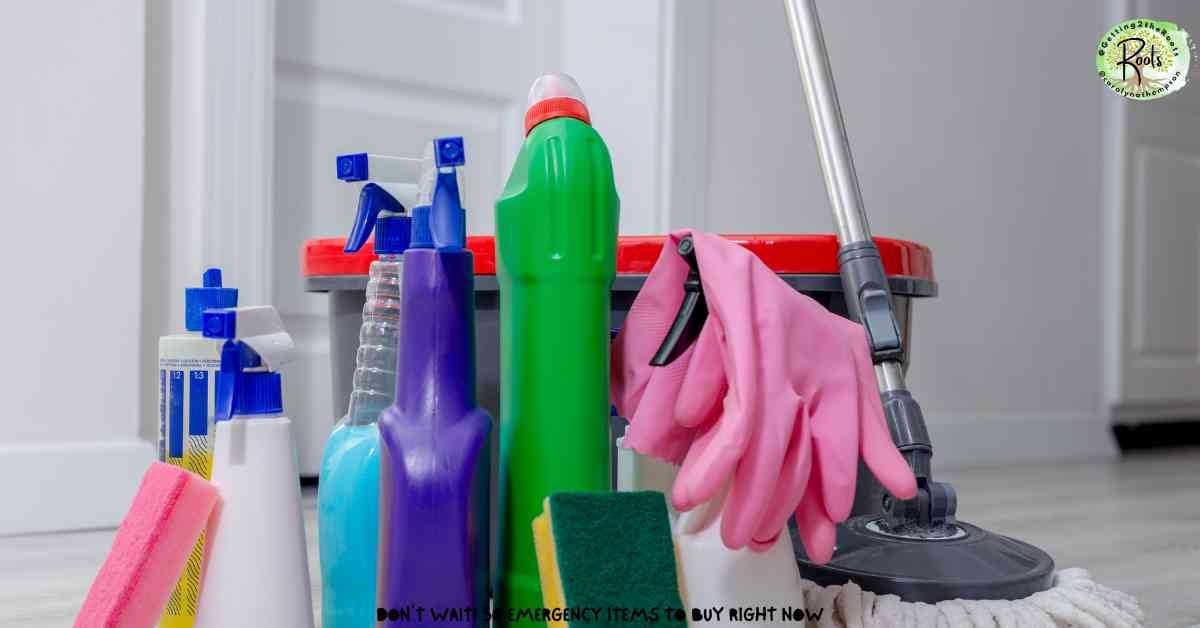
Ziploc bags serve many purposes. They help store food, medicine, and hygiene products. They keep things dry and organized. People always buy them out once the panic begins.
Aluminum foil and plastic wrap vanish just as fast. They protect leftovers and cover food when other tools are limited. These small items carry big weight during uncertain times. They are emergency items you’ll be glad you grabbed early.
Pet supplies run out faster than many expect. Pet food is one of the first things to sell out in the animal care section. Kitty litter is another. These don’t get restocked as fast as human items.
Flea medicine, pet shampoo, and grooming tools also become hard to find. If your pet takes daily medicine, that belongs in your supply too. Pets are part of the family. Their needs matter when everything else feels out of control.
Emergency Items to Replace Wipes or Diapers in a Pinch
Emergency items for babies are essential, but even the best planning can fall short. If you run out of diapers, you can make your own using things already in your home.
Soft towels, old cotton t-shirts, or flannel sheets work well. Fold them into thick layers. Make sure they fit snug but not tight. Secure them with safety pins or use underwear to hold them in place.
Wash reusable cloths with hot water and soap after every use. Let them dry completely before using them again. You can also soak them in a vinegar-water mix to help kill germs.
Wipes are simple to replace. Use warm water with a small amount of soap. Apply it with soft cloths, old baby washcloths, or cotton pads. Rinse and reuse.
Keep a bucket nearby to collect used cloths until you can wash them. Avoid using fabric softeners or scented soaps. These can irritate a baby’s skin. Stick with mild, unscented soap if possible.
Emergency Items That Support Feeding and Comfort
If formula runs out, don’t rush to make your own. Homemade recipes can be dangerous. Speak with a doctor first. Your local WIC office may have resources. Food banks sometimes carry Emergency items like infant formula.
Check parent groups online. Many families share extra supplies during shortages. Some mothers may offer or donate breast milk safely through proper channels.
Bottle nipples wear out too. Keep extras in your emergency items. Clean all feeding supplies with hot water and a small brush. Air dry on a clean towel.
Emergency Items That Help With Hygiene When Sanitary Pads Run Out
Menstrual products often disappear quickly during a crisis. If you run out, use old cotton t-shirts, flannel, or soft towels. Cut them into thick strips. Make sure they’re wide enough to stay in place.
Fold them for added absorption. Use clean, soft materials. Avoid anything scratchy or stiff. Wash used cloth pads right away in hot soapy water. Rinse thoroughly and dry in the sun if possible.
Change them often. Wet cloth can cause irritation if left too long. Carry clean ones in a plastic bag when leaving home. Keep another bag for used items until you can wash them.
If you have a sewing kit, consider making reusable pads. Fold layers of cotton together and stitch the edges. Add a waterproof layer if available. Old pillowcases or sheets work well too.
These emergency items may not be your first choice, but they work when supplies are low. Keeping extra cloth and knowing how to use it gives you one more way to stay clean and prepared.
First Aid Supplies That Save Time and Pain
Wounds need fast care when help is far away. Emergency items like rubbing alcohol help clean cuts and prevent infection. Hydrogen peroxide works well too. Both are easy to store and last a long time.
Antibiotic cream helps wounds heal faster. Use it after cleaning the area. Burn cream or aloe gel can soothe skin after a minor burn or sun exposure.
Band-aids are must-haves. Keep them in many sizes. You’ll need small ones for blisters and larger ones for scrapes. Gauze pads cover deeper cuts. Use medical tape to keep them in place.
Don’t skip gloves. Disposable gloves keep things sterile. They protect both you and the person you’re helping. Always wear gloves when treating blood or open skin.

Tools That Help You Treat Injuries Fast
Tweezers help remove splinters or glass. Scissors cut bandages, tape, or even clothing in an emergency. Cold packs reduce swelling. They’re great for bumps, sprains, or fevers. No freezer needed. Just shake or press to activate.
A thermometer is key. It helps you track fevers. Choose a digital one if possible. It’s faster and easier to read. Pain relievers also belong in your kit. Stock ibuprofen or acetaminophen. Both help lower fever and ease pain.
Cough drops or throat lozenges bring quick relief for dry throats. Medical masks protect you in crowded places. They also help if someone near you is sick. These emergency items keep illness from spreading during tough times.
Prescription Meds and Personal Essentials That Can’t Wait
Don’t forget your daily medications. In a crisis, missing even one dose can be dangerous. emergency items must include a seven-day supply of anything you take regularly.
That means insulin, asthma inhalers, blood pressure pills, and more. Ask your doctor for an extra refill for your emergency kit. Some may approve a second bottle for backup.
Write everything down. List the name of the drug, dosage, and when you take it. Keep this list in your wallet, your bag, or your emergency binder. That way, if you’re injured, someone else can help you stay on track.
Some pharmacies offer pre-packed medication planners. These hold pills by day or dose. They’re a smart way to keep your supplies organized.
Refill reminders help too. Set an alert on your phone. When you restock one bottle, update your emergency stash.
What to Pack When You Have to Leave Fast
Disasters can strike with no warning. Fires, storms, and sudden evacuations leave little time to think. That’s why having a go bag already packed matters. Fill it with the most critical emergency items for at least three days.
Water is your top priority. Pack small bottles that are easy to carry. Add snacks like trail mix, protein bars, or crackers. These last long and take up little space.
Add a flashlight with extra batteries. A headlamp works too. Phones are helpful, but only when charged. That’s why a power bank belongs in your bag. Include a charger cable too.
Important documents must come with you. Use a waterproof folder to hold ID cards, birth certificates, medical records, and insurance papers. Cash is also important. Small bills work best when machines are down.
Bring two or three changes of clothes. Pack socks and underwear. Add a warm sweater and light jacket. Pick sturdy shoes that can handle walking long distances.
Your first aid kit belongs in the go bag. Add travel-sized toiletries like toothbrushes, toothpaste, deodorant, and soap. Feminine products also matter. Keep a small supply ready.
A blanket or small sleeping bag gives comfort and warmth. Pack one for each family member if possible. If you have space, add a foldable rain poncho.
Paper maps are useful if GPS fails. Keep one of your city and one of your region. Add a printed list of emergency contacts. Phones break. Paper doesn’t.
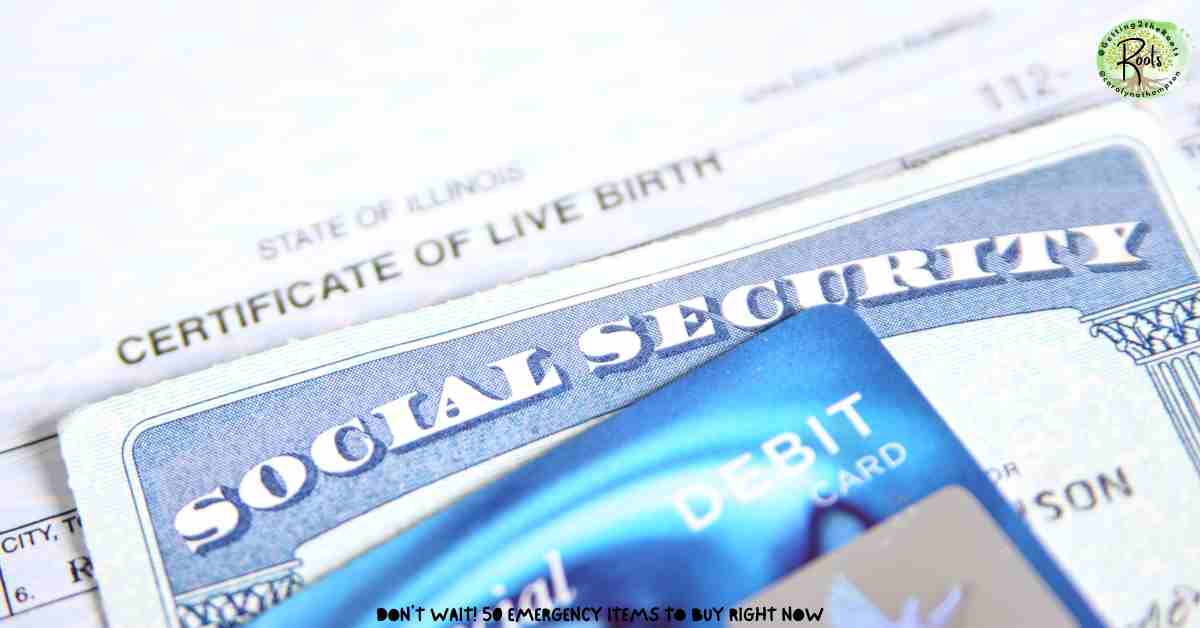
Critical Records You Should Always Keep Ready
Emergency situations often require proof of who you are. You may need to show your name, identity, or insurance status fast. These emergency items should include official documents.
Start with birth certificates. Add Social Security cards and government-issued IDs. Keep health insurance cards close. Also store a copy of any current medical records. These documents save time when care is urgent.
Add your home, renter’s, or car insurance policies. These are hard to replace during a crisis. Make copies of banking details. Include account numbers, branch information, and contact names.
Add legal documents like wills, custody papers, or powers of attorney. These emergency items help others act on your behalf if you cannot. Print out an emergency contact list. Write down phone numbers and addresses.
Add meeting locations in case your family is separated. Paper copies work even when phones don’t.Store digital backups too. Scan your records and upload them to a private cloud folder.
Google Drive or Dropbox both work well. You can also save files on a flash drive. Keep it in your go bag. Snap photos of everything with your phone as an extra layer of backup.
Emergency Items That Help When Systems Shut Down
Cash is easy to forget until you need it. Credit and debit cards depend on working power and internet. When outages hit, they may stop working.
Always keep cash in small bills. Larger ones are harder to use in emergencies. Some places cannot make change during a crisis. Cash lets you buy food, supplies, or shelter without delay.
Fuel is another must. Keep your gas tank at least half full. If roads close or stations run dry, you’ll be stuck. Lines grow long fast when panic spreads. People rush to fill up. Don’t wait for an alert to gas up your car.
Gas cans are helpful too. Store one safely with a lid. If you need to leave quickly, having backup fuel can make a difference. Both fuel and cash are emergency items that give you freedom when others are stuck waiting.
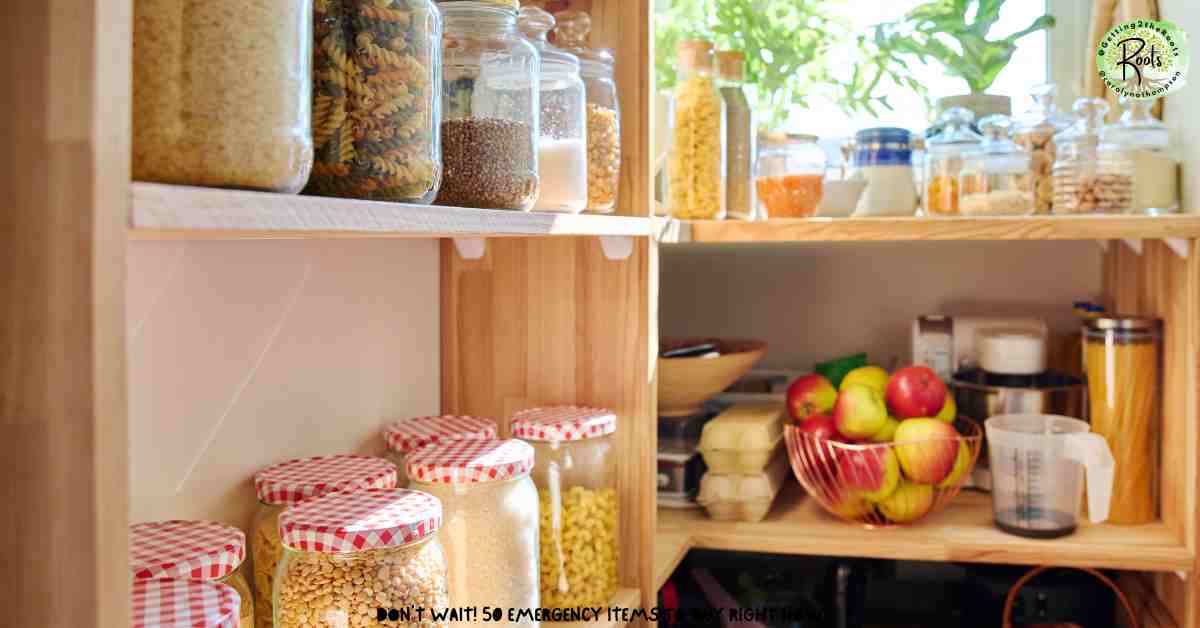
Stocking the Pantry: Food and Cooking Essentials
Food is one of the first things people worry about during a crisis. Emergency items for your pantry should include basic staples. Start with powdered or UHT milk. These have long shelf lives and don’t need refrigeration.
Food is one of the first things people worry about during a crisis. Emergency items for your pantry should include basic staples. Start with powdered or UHT milk. These have long shelf lives and don’t need refrigeration.
Cooking oil is another must. Choose olive or vegetable oil. You’ll need it to prepare meals or add calories. Include sugar, salt, and flour. These may seem simple, but they’re often the first to run out in stores.
Add rice to your emergency supply. It stores well and stretches meals. Pasta is another smart option. It cooks fast and feeds many.
Canned goods are essential. Choose beans for protein and fiber. Pick canned meats like tuna or chicken. Add vegetables and soups for balance. These foods require no refrigeration and last for years.
Peanut butter is a great choice. It lasts long and gives energy fast. It also has protein and healthy fats. Add crackers, instant noodles, and granola bars. These don’t take up much space and offer quick meals when you can’t cook.
Powdered drink mixes help with hydration. Choose Gatorade or electrolyte blends. These replace salts your body loses during heat or illness. They also make plain water easier to drink when stress is high.
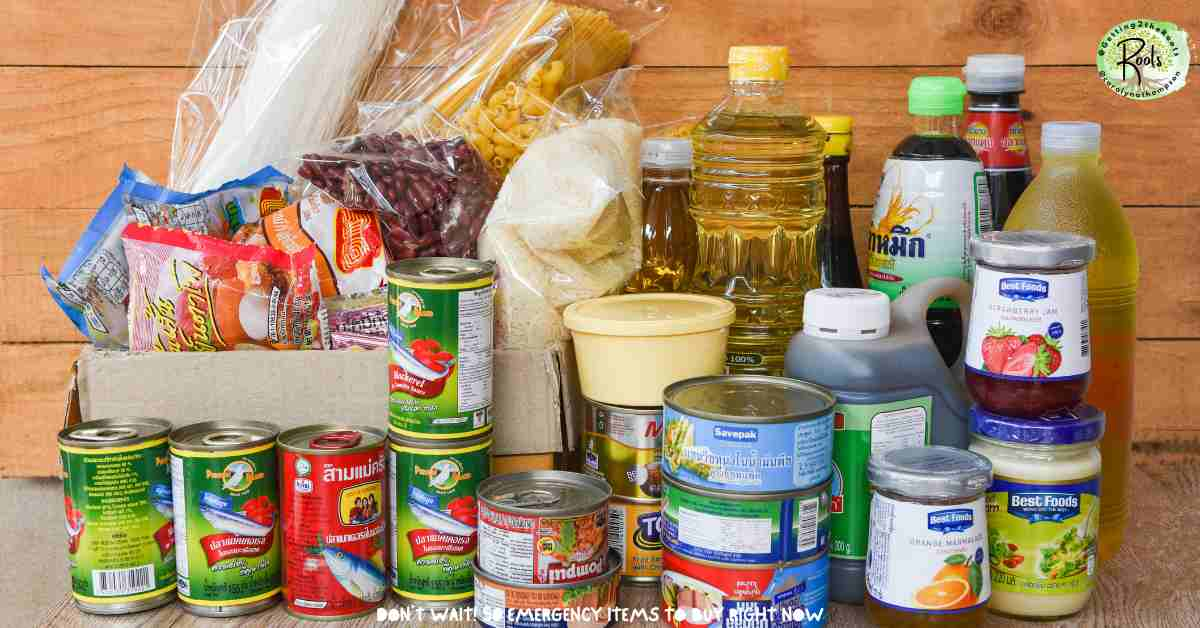
emergency items That Keep You Nourished and Strong
Coffee and tea give comfort and alertness. They store easily and help you stay sharp. Protein powder or meal replacement shakes also belong in your emergency supply.
These help when food is limited or cooking is not possible. Add a bottle of multivitamins. These fill in the gaps when fresh food is not available. Include Vitamin C and Vitamin D.
These boost your immune system and support healing. Emergency items like these protect your health during long disruptions.
Stock extra utensils and can openers. You don’t want to be stuck with canned food and no way to open it. Include paper plates, cups, and plastic forks. These save water and make cleanup easy.
A small camp stove is helpful. Pick one that uses fuel canisters or wood. Keep it stored safely. If the power is out, you’ll need a backup way to cook.
Common Supplies You May Not Think About
Some emergency items are easy to overlook until you need them. Lighters and matches belong in every home. These help you light stoves, candles, or even start a fire outside if needed.
Candles offer backup light when power is out. Store a variety of sizes. Make sure to place them in sturdy holders.
Batteries are another priority. Stock all common types, especially AA, AAA, and D. They power flashlights, radios, and other tools.
Toilet bowl cleaner helps keep your bathroom usable. A dirty toilet can lead to bigger problems fast.
Feminine wash supports personal hygiene. Clean spaces and clean bodies help prevent illness and discomfort.
Personal Items That Offer Comfort and Protection
Gloves protect your hands when cleaning or treating wounds. Keep several pairs in your kit. Choose latex-free if possible.
Medical masks protect you and others during outbreaks. They also block dust and smoke during natural disasters.
Pack cold packs. These treat sprains, bumps, and bruises. They also help bring down fever. Just squeeze or press to activate.
Medical tape helps secure bandages or splints. Emergency items like these don’t take up much room but make a big impact.
Explore Powerful Moments from the Past in One Playlist
Explore More with History in Motion Playlist!
Ready to explore more? Visit the History in Motion category here: History in Motion.
Don’t forget to check out my YouTube channel for videos that bring these stories to life. Together, let’s educate, inspire, and celebrate the incredible legacy of history. Visit “History Truough Black Eyes” Playlist Today!
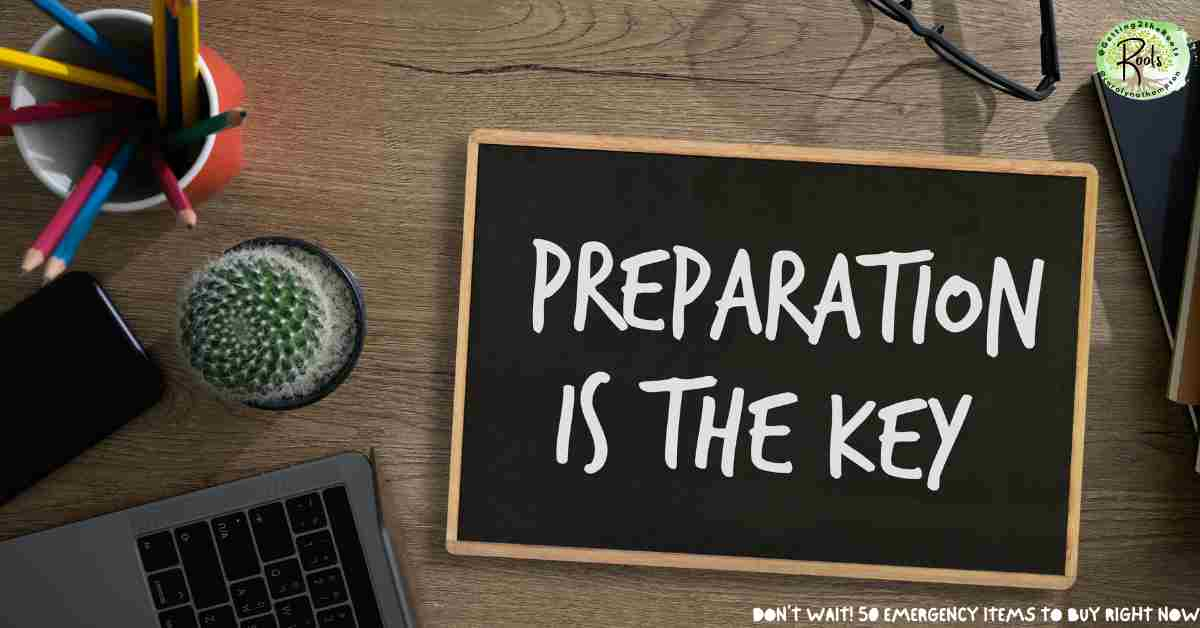
Conclusion
In Conclusion Emergency Items are not just things you grab when trouble starts. They are what keep your family safe when stores close or shelves run empty.
When prices rise or systems break down, what you’ve prepared is what gets you through. Start building now while items are still affordable.
Frequently Asked Questions About Emergency Items
- What are the most important emergency items to buy first?
Start with water, toilet paper, soap, and canned food. These go first in any crisis. - How can I stock up on emergency items on a budget?
Buy a few extra things each week. Use coupons or store sales. Focus on essentials first. - What should go in a basic emergency go-bag?
Water, snacks, ID copies, flashlight, power bank, cash, clothes, and a first aid kit. - Why do emergency items like diapers and formula disappear so fast?
Families need them daily. Stores stock limited amounts. Panic buying empties shelves. - How do I store emergency items long-term?Keep them cool and dry. Use airtight containers. Rotate food and medicine often.

